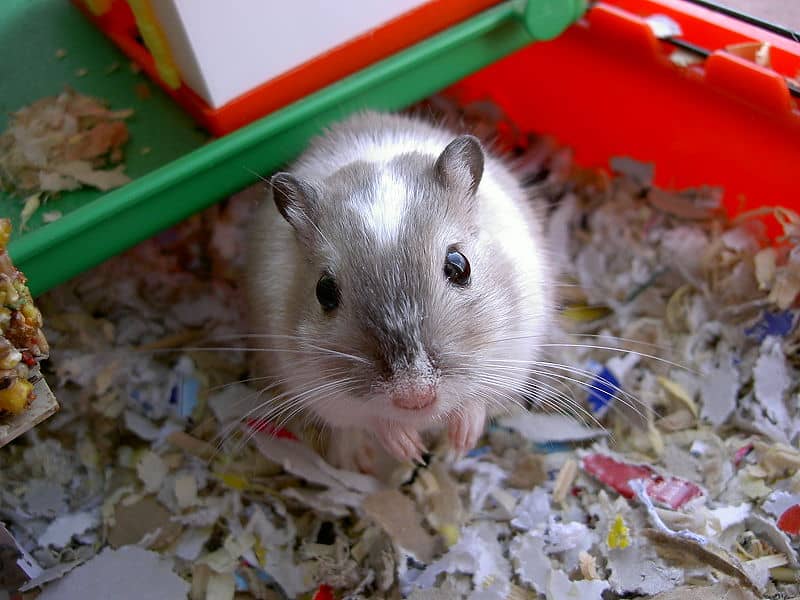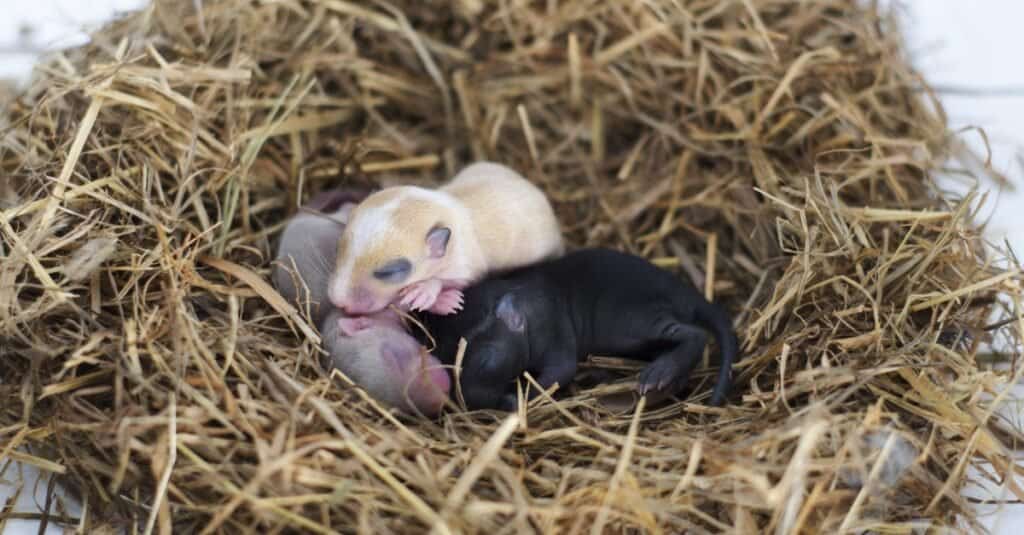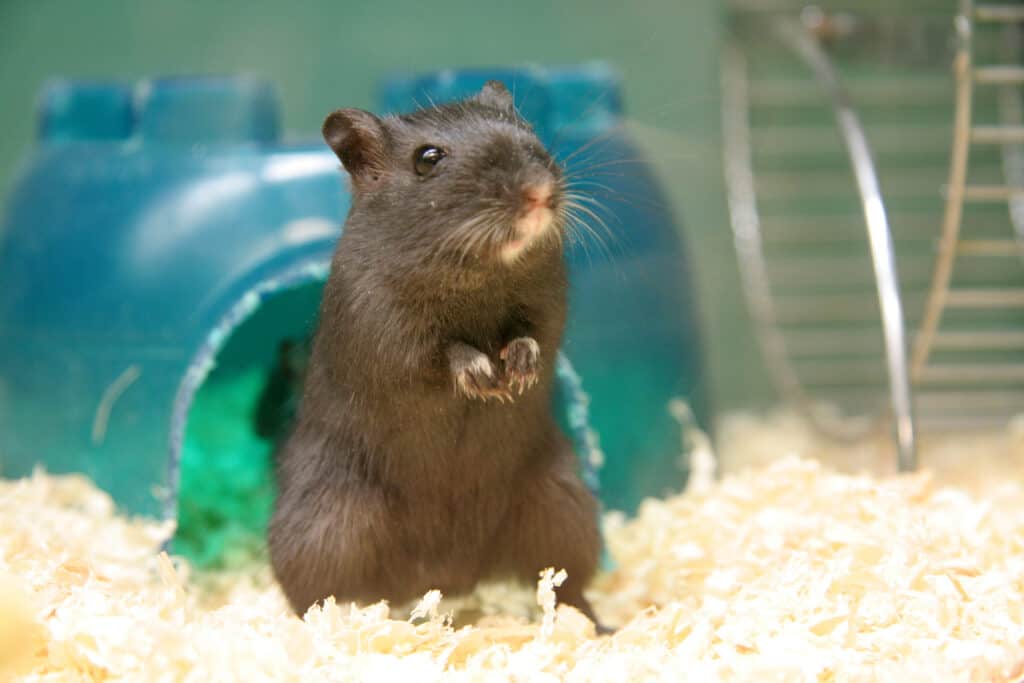Gerbils are native to Africa, Asia, and Eurasia.
People tend to love cute furry little creatures. For instance, gerbil facts include these tiny animals being popular pets, loved by people across the globe. But in the wild, they are social animals native to Africa, Asia, and Eurasia. These omnivorous animals live in burrows in hot deserts, grasslands, and dry savannas. They give birth to large broods several times a year and produce substantial populations depending on the species. So, let’s learn how far beyond cute gerbil facts extend.
1. Gerbils Can Grow to 16 Inches Long

Gerbils are native to
Africa
, Asia, and Eurasia and are known as sand rats.
Gerbils are cute little rodents growing between six and 16 inches long. Another tiny gerbil fact is that they weigh between 0.35 and eight ounces. These animals have thick fur; some have luxurious soft coats while others have coarse hair. Their coats are usually neutral in color to help them blend into their surroundings. Still, their underbellies are generally white or buff.
Their tails are typically half their body’s length but may be longer. The male is sometimes larger than the female, depending on the gerbil species. Still, the sexes are generally the same size. The gerbil’s back feet are long and narrow, and this helps them to jump high into the air. They also use their long claws for digging in the ground.
2. Gerbil Facts Mean They Have Many Different Coat Colors
The natural coat color of a gerbil is golden agouti. This color is a yellow-toned sandy shade with spots of darker brown. But, pet gerbils have 40 different coat color variations. The different gerbil coat colors are black, lilac, dove, golden, red fox, and pink-eyed white. Most gerbils are a solid color, but some can be spotted, patched, or pied.
3. One of 10 Facts About Gerbils – Most Are Social

Gerbils are social,l and pet owners should keep at least two or three in a cage to keep them happy.
©Jearu/Shutterstock.com
People who want gerbils as pets must keep at least two of the same species together. For example, keeping at least two of some species of the same litter, like Mongolian gerbils, will ensure your pets remain happy. Most gerbil species are diurnal, but other species have different body clocks. Some species are active at twilight, some are nocturnal, while others are active throughout the day and night.
When with other gerbils, they will groom, play, and even snuggle at bedtime. Although these rodents are social, they are also territorial and can fight to the death if tensions rise. Gerbils communicate with each other and make sounds like squeaks, grunts, clicks, rattles, and shrieks. They will sometimes drum their hind feet if they become agitated.
4. Gerbils Live Across Africa, Asia, and Eurasia
Gerbils live in dry habitats like deserts, rocky areas, or savannas. Some gerbils, like the Gorongoza gerbil, inhabit the moist savannas of southeastern Africa. But some gerbils are endemic to one country, and examples of these are the following:
- Przewalski’s gerbil is endemic to China
- Cape Gerbil is endemic to South Africa
- Rupicolous gerbil is endemic to Mali
- Cheng’s jird (sand rat) is endemic to the Turpan Depression in the autonomous region of Xinjiang in China.
As pets, gerbils need a cage or enclosure that is as large as possible. These animals are active and thrive in glass aquariums. Pet owners should fill these containers with a substrate, like sawdust, so the gerbils have something to dig. Gerbils also need a nest box to hide in and to sleep. Yet another gerbil fact that pet owners should be aware of is that they love chewing and gnawing on things. So, ensure the nest box is made from a strong material, like terracotta or stone. They also need toys that are not hazardous to chew on and an exercise wheel.
5. Gerbil Fact: These Furry Critters Are Omnivores

Gerbil fur has an evolutionary adaption that protects them from sunburn.
©iStock.com/Skyimages
These rodents eat plant and animal material but prefer plants. Gerbils consume seeds, nuts, roots, grass, and fruit in the wild. They also consume animal products like bird eggs, newly hatched chicks, insects, and even other gerbils. However, as pets, you can feed them with commercial food, with pellets being the best option. Also, they love treats like raisins, currants, nuts, sunflower seeds, and mealworms. Feeding them treats will build trust and encourage bonding. You can also give them dog biscuits to chew, as these will help them keep their teeth at the right length.
6. Gerbil Fact – They Face Many Predators And Threats
In the wild, gerbils are a favorite food of many carnivorous animals. Their common predators are owls, foxes, and snakes. They are also vulnerable to pest infections, like fleas. People pose an additional threat to wild gerbils because they hunt them for their fur. Another gerbil fact is that they face habitat loss due to human development.
7. Most Gerbils Can Breed All Year Round

Gerbil pups are born naked with closed eyes.
©February Sweet/Shutterstock.com
Female gerbils are polyestrous, meaning they can give birth to more than one brood each year. Female gerbils can enter estrus immediately after giving birth and become pregnant with the next brood while nursing their current brood. Some gerbil species share parental duties.
Gerbils birth from four to seven pups. They are born with their eyes closed and naked, but their fur grows from eight to 13 days. Their coat is fully grown after two weeks, but their eyes remain closed. Once they are a month old, the mother weans her pups, which reach maturity after about two months. Female gerbils move the brood from nest to nest during the first few days and change burrows after every litter.
8. Some Gerbil Species Are Endangered

Gerbils love to cuddle, play and sleep together.
©iStock.com/Skyimages
Gerbil species like the Arabian, Dahl’s, Buxton’s, and Zarudny’s jirds are endangered. Cheng’s jird is critically endangered and the Principal gerbil, which lives in Sudan, has less than 250 gerbils in the wild. The Ammodile, a gerbil that lives in Somalia, is under threat due to habitat loss. But, most species are not in danger of extinction. Researchers cannot determine accurate figures for gerbil numbers but estimate that there are hundreds of thousands because females produce several broods a year.
9. Gerbil Fur Facts Include a Sunblock Attribute
Gerbils live in dry, arid areas in the wild, where they are exposed to the day’s heat. Because they are primarily diurnal, they would be vulnerable to sun damage. However, their fur has an evolutionary adaption that protects them from sunburn.
10. Facts About Gerbils – They Wash Their Fur in Sand

Pet owners should give their gerbils chinchilla dust to roll in as they will use this to clean themselves.
©iStock.com/Devonyu
Wild gerbils wash in the sand rather than in water. They roll around in the sand, removing dirt and debris from their coats. Pet owners should give their gerbils chinchilla dust to roll in as they will use this to clean themselves.
Up Next: Cute Pet Rodents
- Pet Gerbil Guide: What To Know, What You’ll Need
- Pet Chinchilla Guide: What To Know
- Do Rats Make Good Pets?
- Syrian Hamster
- Guinea Pig Types: The Ultimate Guide To Guinea Pig Breeds
The photo featured at the top of this post is © iStock.com/Devonyu
Sources
- Kidadl, Available here: https://kidadl.com/facts/animals/gerbil-facts
- GerbilWelfare.com, Available here: https://www.gerbilwelfare.com/interesting-gerbil-facts/
- Pet Keen, Available here: https://petkeen.com/gerbil-facts/
- Merck & Co., Inc., Available here: https://www.msdvetmanual.com/exotic-and-laboratory-animals/rodents/gerbils
- PETA, Available here: https://www.peta.org/issues/animal-companion-issues/animal-companion-factsheets/facts-gerbils-hamsters/
Thank you for reading! Have some feedback for us? Contact the AZ Animals editorial team.






